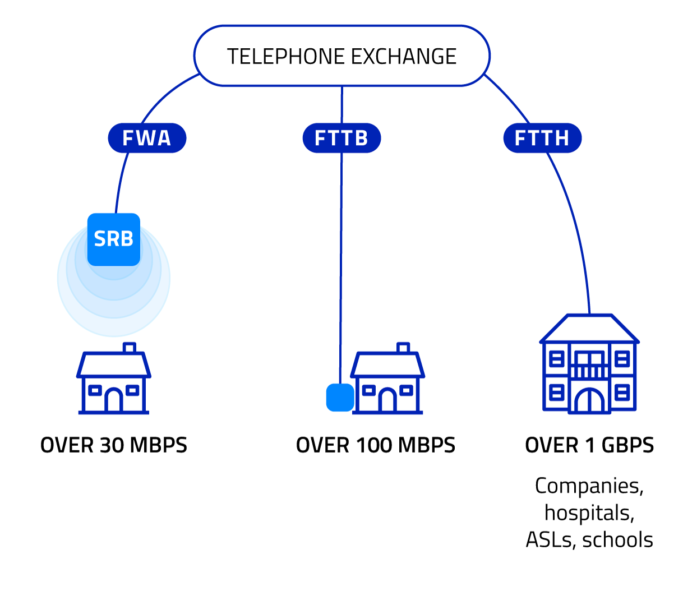The Technology – Ultra-Broadband
BROADBAND: In the telecommunications field, the term Broadband generally indicates the transmission and reception of information at a connection speed higher than 2Mbit/s.
ULTRA BROADBAND: Ultra-broadband refers to an actual connection speed for downloading of at least 30 Mbit/s. Networks that can provide such speeds are referred to as NGA (Next Generation Access) networks.
When the connection speed is significantly higher than 100Mit/s in download and can reach Gbit/s, reference is made to NGA-VHCN (Very High Capacity Networks) networks. These networks are largely based on “FTTDP-Fiber to Distribution Point” type architectures or with similar performance.
BIT RATE (baud rate): indicates the number of bits transmitted or received over a telecommunications channel within a unit of time. The Bit rate then quantifies how much information can be transmitted and received, per second, in terms of bits or multiples thereof, typically Mbit/s (Mega) or Gbit/s(Giga; 1.000 Mbit/s are equal to 1Gbit/s). The higher the guaranteed bit rate is, the higher the quality of service provided.
FTTN: acronym of Fiber To The Node. It indicates an infrastructure in which the optical fibre terminates at an intermediate node of the access network or at a link node to radio carrier access systems.
FTTDP: acronym of Fiber To The Distribution Point. It indicates an infrastructure in which the optical fibre terminates at an optical termination point (Distribution Point) located 50 metres or less away from the Real Estate Unit (REU);
FTTB: acronym of Fiber To The Building. It indicates an infrastructure in which the optical fibre terminates at an optical termination point located at the basis of the building which houses the Real Estate Unit (REU);
FTTH: acronym of Fiber To The Home. It indicates an infrastructure in which the optical fibre terminates at an optical termination point inside the Real Estate Unit (REU).
LATENCY: represents the time it takes a bit to travel a certain distance. In general, in telecommunications, it represents the delay between the moment of the request for information and the instant in which the information is received by the user. The lower the latency time, the higher the quality of service provided.
QUALITY OF SERVICE or QoS: indicates a set of parameters used to characterise the quality of a service offered on a telecommunications network. The main parameters include the bit rate, latency and throughput.
SYMMETRY OF CONNECTION: shows parity of bit rate between download and upload of data and/or information.
THROUGHPUT: indicates the maximum capacity of information a network can support (static throughput) or manage (dynamic throughput). The latter is dependent on the management potential (control plan). The higher the throughput, the better the quality of service.


